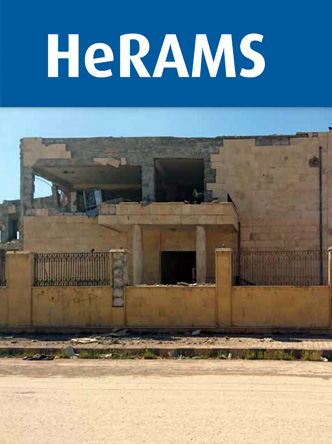HeRAMS (Health Resources and Services Availability Monitoring System) is a global health information management tool (for mapping, collection, collation and analysis of information on health resources and services) that aims to provide timely, relevant and reliable information for decision-making. It is used to guide interventions at the primary and secondary care levels, measure gaps and improve resource planning, ensure that actions are evidence-based, and enhance the coordination and accountability of WHO and other health sector partners.
HeRAMS was adapted for Syria in early 2013, after many consultative meetings with the Syrian Ministry of Health and health sector partners to customize the tool according to the priority identified areas of the health sector.
The key information that is assessed through HeRAMS includes the functionality status, accessibility, health infrastructure, human resources, availability of health services, equipment, medicines at primary and secondary care level.
HeRAMS Health centres assessment tool | Arabic
HeRAMS Hospitals assessment tool | Arabic
Objectives
HeRAMS is developed to provide timely, relevant, and reliable information about the available health resources, to decision-makers, in order to support them in:
- monitoring health situation at primary health care and secondary care levels
- measuring gaps and improving planning of resources
- ensuring evidence-based actions
- enhancing coordination and accountability.

Process and methodology
HeRAMS in Syria is a World Health Organization (WHO) project that aims at strengthening the collection and analysis of information on the availability of health resources and services in Syria at health facility level.
A team of national health staff from all governorates was formulated for HeRAMS reporting, and different data collection mechanisms were introduced to address the shortage of timely and relevant information. The main HeRAMS tool for collecting data is a questionnaire that assesses the functionality status, accessibility, health infrastructure, human resources, availability of health services, equipment and medicines at primary and secondary care level.
Periodicity of reporting is monthly for hospitals and quarterly for health centres.
Data are verified rigorously with data collectors and cross-checked randomly with other sources at governorate level.
Currently, HeRAMS has been expanded to cover Ministry of Higher Education hospitals, UNRWA health centres, SARC health centres, NGOs health centres supported by WHO, and private hospitals in Al-Hasakeh governorate.
The main challenges faced during data collection and reporting were accessibility and security, as well as continuous power cuts and lack of network coverage in many governorates.
HeRAMS products
- Statistical and analytical reports on the functionality status, accessibility, infrastructure patterns, availability of health resources, health services, medicines and equipment in hospitals and health centres, at governorates and district levels.
- Trend analysis on functionality status of health facilities.
- Comprehensive set of maps to visualize the produced analysis.
HeRAMS
2021
Annual report 2021: public health centres
Annual report 2021: public hospitals
Annual report 2021: UNRWA/SARC health centres
Annual report 2021: UNRWA health centres
2020
Annual report 2020: NGOs health centres supported by WHO
Annual report 2020: public health centres
Annual report 2020: private hospitals in Al-Hasakeh Governorate
Annual report 2020: UNRWA health centres
Annual report 2020: public hospitals
Annual report 2020: SARC health centres
Bi-annual report on public health centres, January-June 2020
Bi-annual report on public hospitals, January-June 2020
2019
Annual report 2019: public health centres
Annual report 2019: public hospitals
Annual report 2019: private hospitals
Annual report 2019: SARC health centres
Annual report 2019: UNRWA health centres
Annual report 2019: NGO health centres
Annual report 2018: public hospitals
Annual report 2018: public health centres
Snapshot of public hospitals, December 2018
Snapshot of public health centres, third quarter, 2018
Snapshot of public hospitals, November 2018
Snapshot of public hospitals, October 2018
HeRAMS summary report, April–June 2018
Snapshot of public hospitals, September 2018
Snapshot of public health centres, second quarter 2018
HeRAMS summary report, January-March 2018
Snapshot of public hospitals, August 2018
Snapshot of public hospitals, May 2018
Snapshot of public health centres, first quarter 2018
Snapshot of public hospitals, April 2018
Snapshot of public hospitals, March 2018
Annual report 2017: public hospitals
Annual report 2017: public health centres
Snapshot of public health centres, October–December 2017
Snapshot of public hospitals, December 2017
Snapshot of public hospitals, November 2017
Snapshot of public health centres, July–September 2017
Snapshot of public hospitals, October 2017
Snapshot of public hospitals, September 2017
Snapshot of public hospitals, August 2017
Snapshot for public health centres, April–June 2017
Snapshot of public hospitals, July 2017
Snapshot of public hospitals, June 2017
Snapshot of public hospitals, May 2017
Snapshot for public health centres, January–March 2017
Snapshot of public hospitals, April 2017
Snapshot of public hospitals, March 2017




